Well The Great Frogtastic Inventions Trail is over and soon all frogs will be hopping off to their news home, so I thought I’d share some information about the amazing artists who have lent their artistic skills to such a wonderful art project. These amazing frogs will be auctioned off and you have the chance to buy one, the auction finishes on 2nd November so you’ve still got time to get your hands on your favourite one. Each sculpture will be raising money for different charities so it’s a brilliant way to give back to your local community while also getting an original piece of art. Below you’ll find links to the artists website, the auction lot number and the charity they’re raising money for.
Frog 1. “DJ” – The IPod – By Sian Ellis

Do you remember the days when you had to carry around a bulky CD player and a bunch of CDs to listen to your favourite tunes? Well, thanks to the invention of the iPod, those days are long gone. The iPod was a revolutionary device that changed the way we enjoy music. It was created by Apple in 2001, and it allowed users to store thousands of songs in a sleek and portable gadget. The iPod also introduced the concept of iTunes, a digital music store that let users buy and download songs online. The iPod was not only a technological breakthrough, but also a cultural phenomenon. It inspired countless accessories, parodies, and memes. The iPod was truly a game changer in the history of music and entertainment.
Sponsored by : Plumlife Homes
Instagram : @sianellisartist
Website : https://sianellisillustration.co.uk/
Auction : Lot 12
Charity : Seashell Trust
Frog 2. “Frogwarts” – The Engine – by Greg Williamson
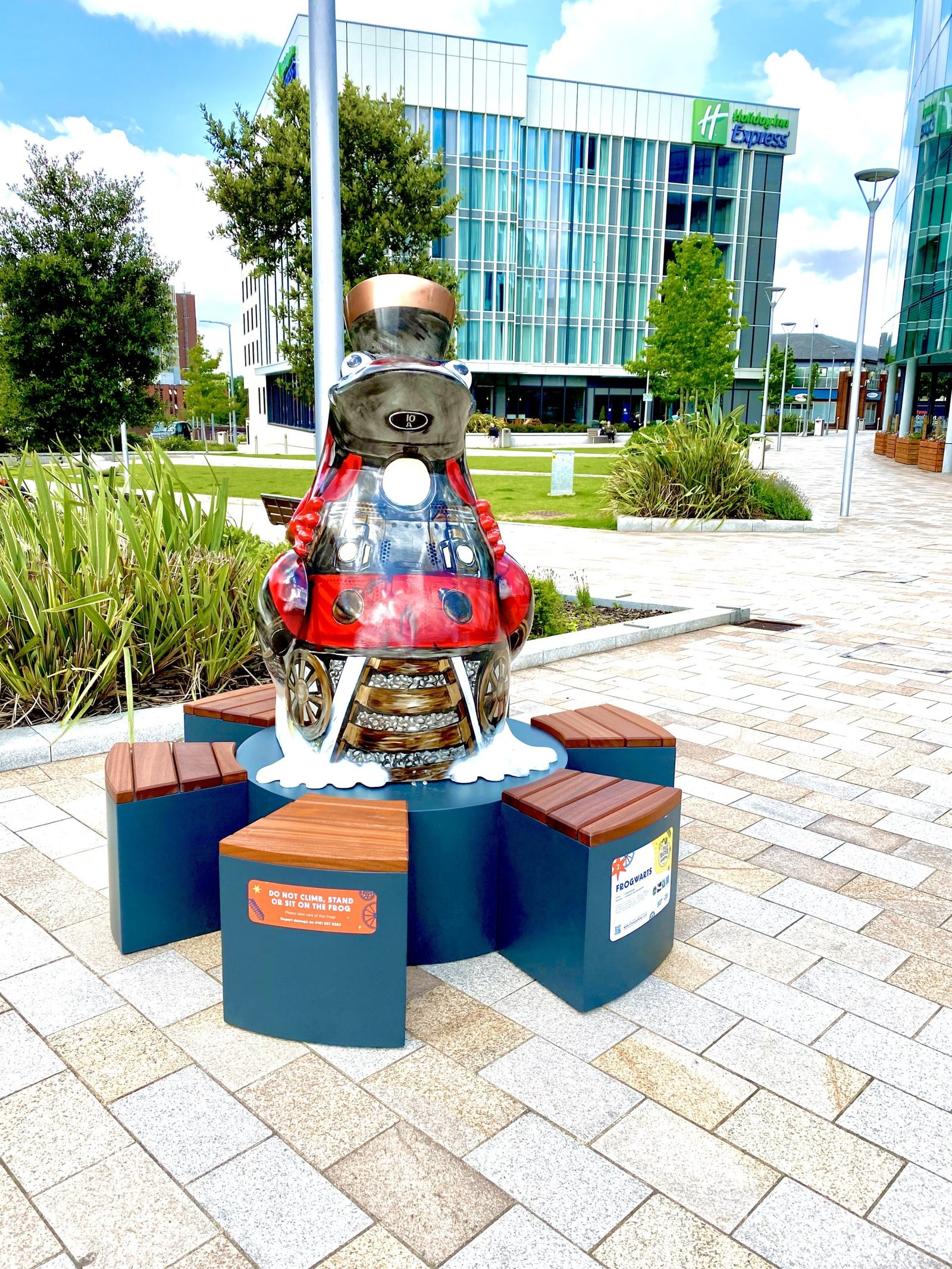
The invention of the engine was a game changer for humanity. Before that, people had to rely on horses, windmills, or their own muscles to get things done. But with the engine, they could power machines, vehicles, and factories with ease. The engine also made possible new inventions like airplanes, cars, and rockets. Imagine living in a world without engines. You would have no electricity, no internet, no smartphones. You’d have to do everything by hand, like a caveman! That’s why we should be grateful for the genius who invented the engine. Who was it, you ask? Well, that’s a tricky question. There were many people who contributed to the development of the engine over time. Some of the most famous ones are Thomas Newcomen, James Watt, and Nikolaus Otto. They gave us the power to move the world.
Sponsored by : Mid-Cheshire Railway, Crewe to Manchester and South-East Railway
Instagram : @sharkmanart
Website : https://www.sharkmanart.co.uk/
Frog 3. “Orville” – The Airplane – By Katie Scott

The invention of the airplane was a remarkable feat of human ingenuity and courage. It all started with two brothers, Wilbur and Orville Wright, who had a passion for flying and a knack for tinkering. They built a series of gliders and tested them in the windy hills of Kitty Hawk, North Carolina. After many trials and errors, they finally achieved the first powered, controlled, and sustained flight on December 17, 1903. Their airplane flew for 12 seconds and covered 120 feet, which is less than the wingspan of a Boeing 747. But it was enough to change the world forever. The Wright brothers became famous and inspired generations of aviators and inventors. They also proved that humans can do anything they set their minds to, even if it means defying gravity and common sense.
Sponsored by : Holiday Inn Express
Instagram : @katiescott_creative
Website : https://www.katiescottcreative.uk/
Auction : Lot 2
Charity : AustiSK
Frog 4. “Spoke” – The Wheel – By yours truly

The wheel is one of the most amazing inventions in human history…but I may be a bot biased as I had to paint a design based on it! It was invented around 3500 BCE by some clever people in Mesopotamia, who used it for pottery making, then figured out they could also use them for moving stuff and going fast. They hooked up wheels to horses and carts, and boom, transportation was born.
But did you know that the wheel also had a role in the industrial revolution? In 1732 Stockport used the first water powered textile mill in the North West of England. The mill used a water wheel to spin cotton and make cloth. The wheel helped Stockport become a centre of industry and trade in the 18th and 19th centuries. Wheels literally changed the world. They made travel, machines, and exploration easier. We still use wheels today for all kinds of things, they’re a sign of progress, innovation, and creativity.
Sponsored by : Stockport Council
Auction : Lot 8
Charity : Beacon Counselling
Frog 5. ” Gugli” – The Radio – By Jo Wathan

The invention of the radio was a major breakthrough in the history of communication. It enabled people to transmit and receive sounds over long distances, without wires or cables. The radio opened up new possibilities for entertainment, education, and allowed people to spy on each other. The radio was invented by several people who had different ideas and methods, but the most famous one was Guglielmo Marconi. He was an Italian engineer who sent the first wireless signal across the Atlantic Ocean in 1901. He used a transmitter powered by a battery and a spark coil, and a receiver with a coherer and a telegraph key. He was so proud of his achievement that he named his dog Sparky. Just kidding, I made that up. But he did win a Nobel Prize for his work, along with Karl Ferdinand Braun, in 1909, which is pretty cool.
Instagram : @charmingbadger
Website : https://www.charmingbadger.com/
Auction : Lot 7
Charity : Chelwood Food Bank
Frog 6. “Zippy” – The Zip – By Douglas Hutton

Did you know that the zipper was not always called a zipper? It was originally named the “clasp locker” by its inventor Whitcomb Judson, who patented it in 1892. But his design was not very popular, probably because it sounded like a torture device! It took another engineer, Gideon Sundback, to improve the fastener and make it more user friendly. He called it the “separable fastener”, which was not much better. Finally, in 1923, a company called B. F. Goodrich used the fastener on their rubber boots and gave it the catchy name “zipper”, because of the sound it made when you zipped it up or down. And that’s how the zipper became a ziptastic part of our everyday life!
Sponsored by : The Fostering Group
Facebook : @douglashuttonart
Website : https://www.douglashuttonart.com
Auction : Lot 1
Charity : Beechwood Cancer Care
Frog 7. “Ringo” – The Telephone – By Sally Bamford

The invention of the telephone was a major breakthrough in human communication. It allowed people to talk to each other over long distances, without having to send letters or telegrams. The first successful telephone call was made by Alexander Graham Bell in 1876, when he said to his assistant, “Mr. Watson, come here. I want to see you.” It’s not clear what he wanted to see him for, but maybe he just wanted to show off his new invention. Or maybe he needed some help with the wires. Either way, it was a historic moment that changed the world forever.
Sponsored by: Merseyway
Instagram : @little_betty_design
Website : https://www.etsy.com/uk/shop/littleBettyprint
Auction : Lot 10
Charity : Diabetes UK
Frog 8. “Minty” – Currency – By Benjamin McChrystal Plimmer

The invention of currency was a brilliant idea that changed the world. Before currency, people had to barter for everything they wanted, which was very inconvenient and inefficient. Imagine having to trade your chickens for some bread, or your cow for some clothes. How would you know how many chickens are worth a loaf of bread, or how many cows are worth a shirt? And what if you didn’t have anything to trade, or the other person didn’t want what you had? Currency solved these problems by creating a common medium of exchange that everyone could use and trust. Currency also made it easier to store and measure wealth, and to facilitate trade and commerce across long distances.
Sponsored by : Moorcroft Group PLC
Instagram : @sugarybenny
Website : https://www.sugarybenny.com/
Sold ahead of the auction to raise money for Walthew House.
Frog 9. “Needles” – The Vaccine – By Helen Naylor

The invention of the vaccine was a huge breakthrough for science and for humanity. It’s saved millions of lives from deadly diseases and made the world a safer place. But did you know that the first vaccine was made by accident? A guy named Edward Jenner noticed that milkmaids who got cowpox didn’t get smallpox. So he decided to inject some cowpox pus into a boy’s arm and see what happened…ewww! Luckily, the boy didn’t die and became immune to smallpox. And boom, that’s how the vaccine was born.
Instagram : @pocketwren
Website : https://www.pocketwren.co.uk/
Auction : Lot 15
Charity : Stockport Mind
Frog 10. “Bones” – The X ray – By Emily D’Andrea

Did you know that the x-ray was invented by accident? In 1895, a German physicist named Wilhelm Röntgen was experimenting with cathode rays and noticed that a screen coated with a fluorescent material was glowing even when he covered the tube with a thick cardboard. He realised that some invisible rays were passing through the cardboard and called them x-rays, because he didn’t know what they were. He also discovered that these rays could penetrate other objects, such as bones and metal, and produce images on photographic plates. He was so amazed by his discovery that he took the first x-ray picture of his wife’s hand, which showed her wedding ring and her bones. She was not very amused and said “I have seen my death.” Awkward!
Sponsored by : Stockport County F.C
Instagram : @lobsterhousestudios
Website : https://lobsterhousestudios.com/
Auction : Lot 13
Charity : Stockport Community Trust
Frog 11. “Poppy The Space Frog” – The Space Race -By Poppy Crowe

The space race was a competition between the United States and the Soviet Union to see who could get to the moon first. It started in 1957, when the Soviets launched Sputnik, the first artificial satellite. The Americans were shocked and scared that the Soviets had such advanced technology. They decided to catch up by creating NASA and sending astronauts into orbit. The space race was also a way of showing off their political and economic power to the world. The space race ended in 1969, when Neil Armstrong became the first human to walk on the moon. He said, “That’s one small step for man, one giant leap for mankind.” Some people think that the space race was a waste of money and resources, but others think that it was a great achievement for humanity and science.
Sponsored by : Europlanters
Sold ahead of the auction to raise money for The Wellspring.
Frog 12. “Gizmo” – The Gizmotron – Designed by David Haworth

The gizmotron is a device that makes guitars sound like orchestras. It was invented by Lol Creme and Kevin Godley, two members of the band 10cc, in the 1970s. They wanted to create a new sound for their music, but they didn’t have enough money to hire a real orchestra. So they came up with the idea of attaching small plastic wheels to the strings of their guitars. The wheels would spin and pluck the strings, creating a rich and layered sound. The gizmotron was a brilliant invention, but it was also very fragile and difficult to use. It often broke down or went out of tune. Only a few musicians managed to master it, such as Jimmy Page and Eddie Van Halen. The gizmotron is now a rare and coveted item among guitar collectors and enthusiasts.
Painted by Greg Williamson
Instagram : @david_haworth_theatre
Auction : Lot 6
Charity : Cherry Tree Project
Frog 13. “Slinky” – The Slinky – By Lucy Burgess
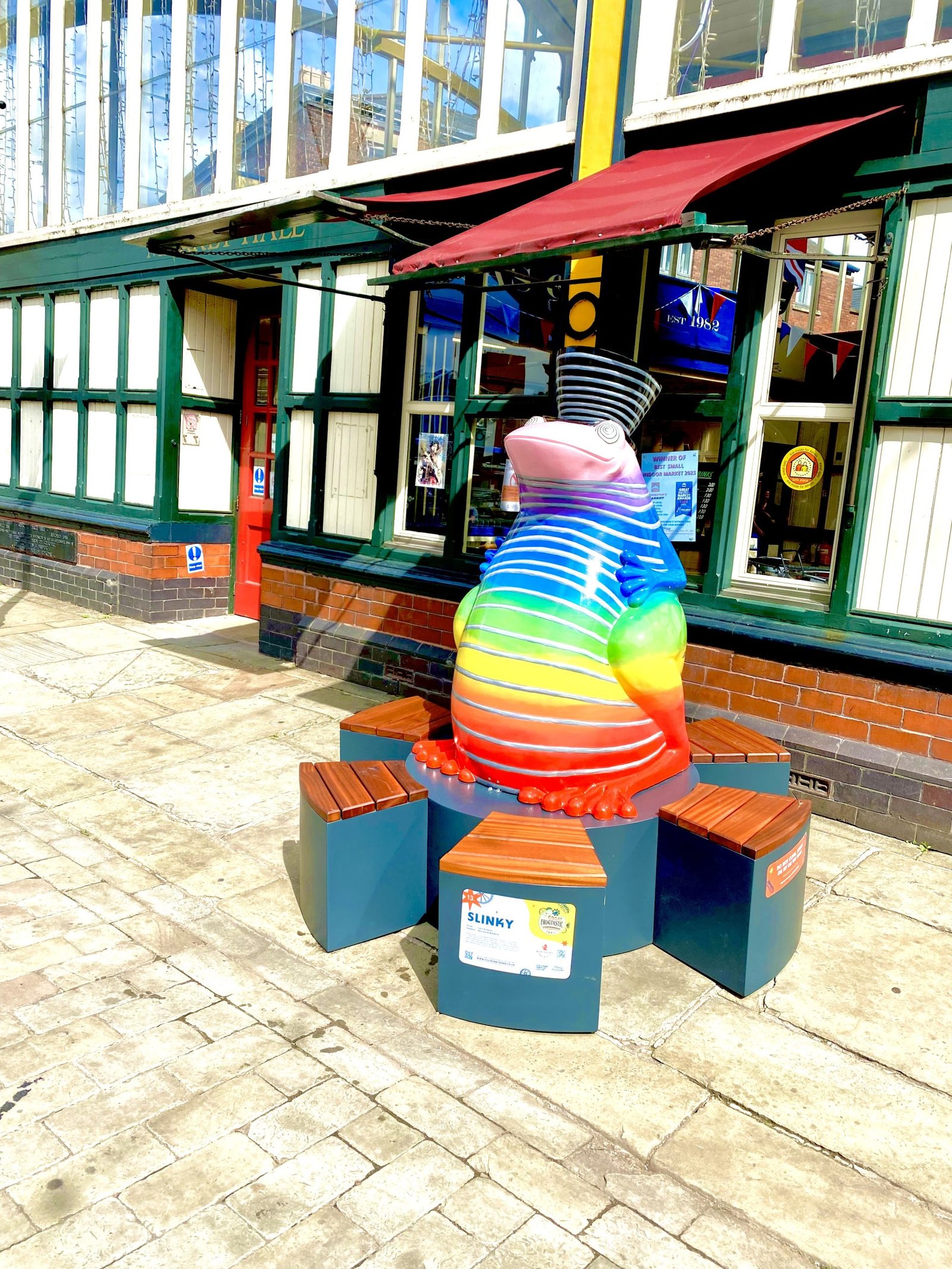
Did you know that the Slinky was invented by accident? A naval engineer named Richard James was trying to make springs that could keep equipment steady on ships, but he dropped one and it started to walk down the stairs! He thought it was cool, so he showed it to his wife Betty, who came up with the name Slinky. They started a company and sold millions of Slinkys to kids and adults who loved to watch them tumble and levitate. The Slinky is a spring, a spring, a marvellous thing!
Sponsored by : Robinsons Brewery
Instagram : @lucyburgessart
Website : https://lucyburgessartist.com/
Auction : Lot 9
Charity : Help For Heroes
Frog 14. “Ronald” – The Burger – By Douglas Hutton
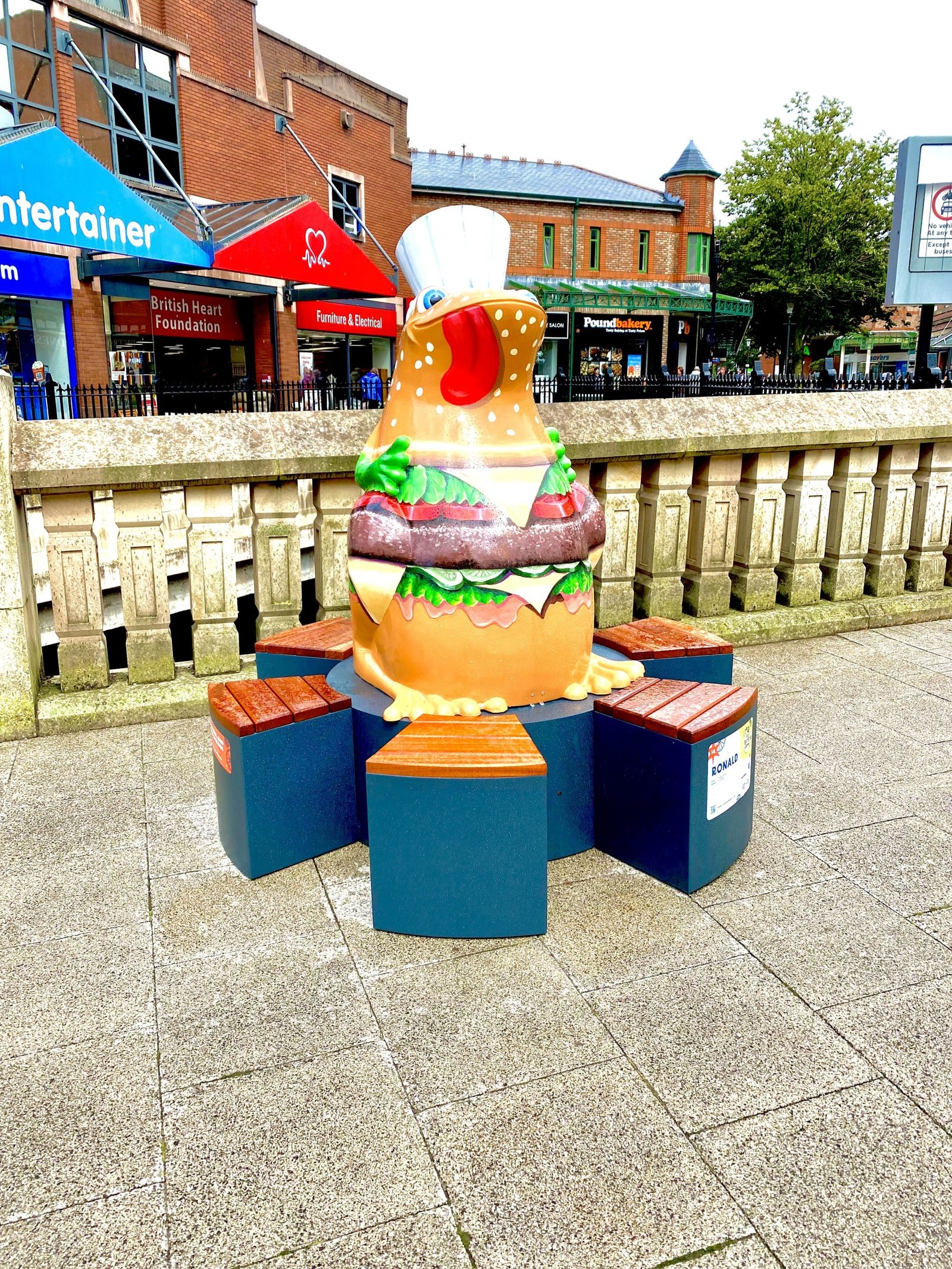
Did you know that the burger was invented by a German chef named Otto Kuase? He was working at a restaurant in Hamburg in 1891, when he had a brilliant idea. He decided to put a beef patty between two slices of bread, and serve it with a fried egg on top. He called it the “Hamburg steak sandwich”, and it was a hit with his customers. He soon became famous for his creation, and people from all over the world came to taste his delicious invention. Some say that he was inspired by the Mongolian horsemen, who used to tenderize meat under their saddles. Others say that he just wanted to make something quick and easy for the busy workers. Whatever the reason, we can all agree that Otto Kuase was a genius, and we owe him a big thank you for giving us the burger.
Sponsored by : McDonalds
Facebook : @douglashuttonart
Website : https://www.douglashuttonart.com
Frog 15. “Colin Da Frog” – The Calendar – By Claire Byrom
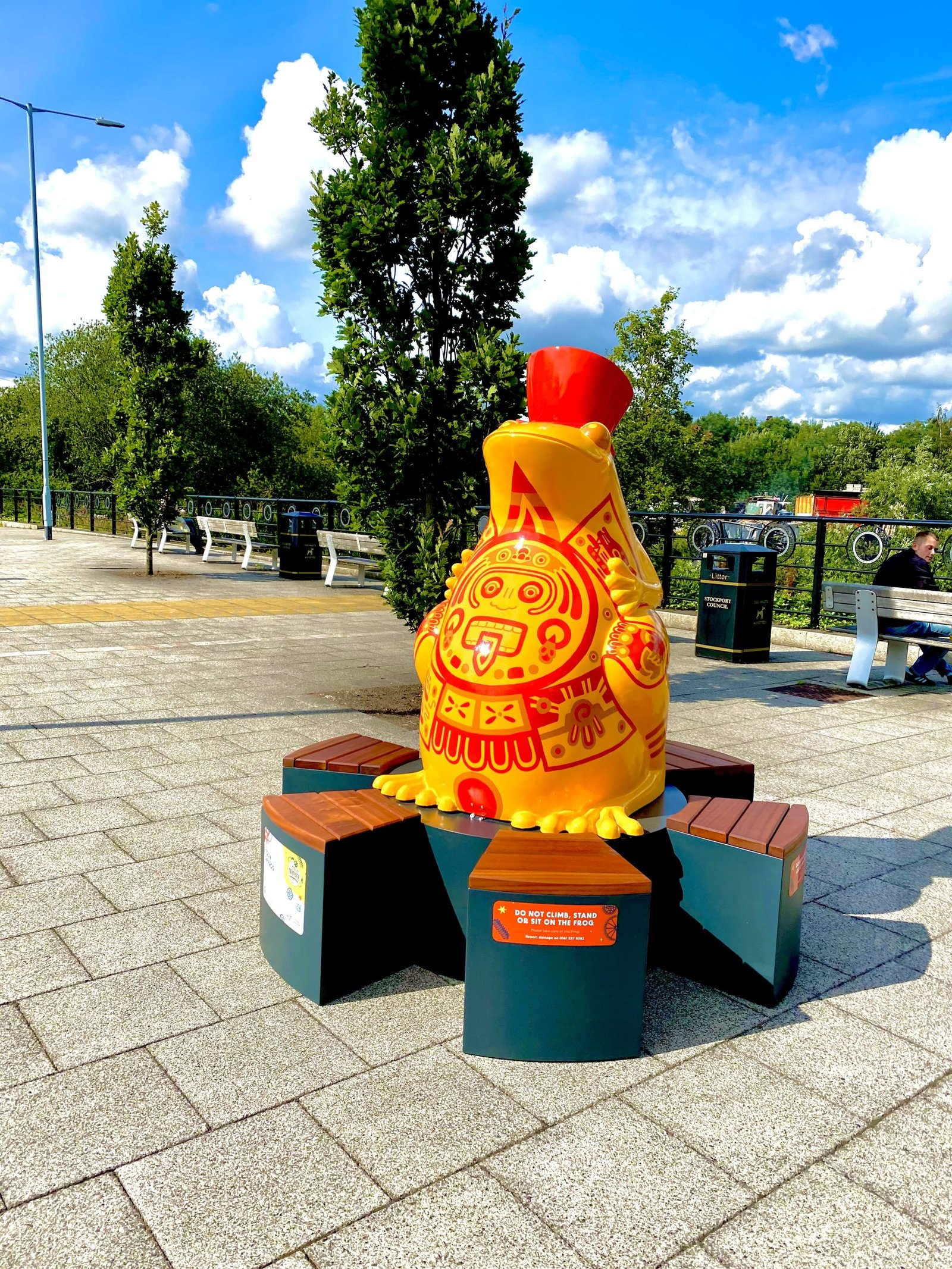
Have you ever wondered who came up with the idea of the calendar? Well, it wasn’t just one person, but many different civilisations over thousands of years. They all had their own ways of measuring time, based on the cycles of the sun, moon and stars. Some of them were pretty accurate, like the Egyptians and the Mayans, while others were a bit off, like the Romans who had to add an extra month every few years to catch up. The calendar we use today is mostly based on the Gregorian calendar, which was introduced by Pope Gregory XIII in 1582. He wanted to fix the problem of Easter being celebrated on different dates by different churches. He also wanted to show off his math skills and impress his friends. The Gregorian calendar is not perfect either, but it’s close enough for most purposes.
Instagram : @Artworks54
Website : http://www.artworks54.co.uk/
Auction : Lot 3
Charity : St Ann’s Hospice
Frog 16. “Eliza” – Artificial Intelligence – By Neil Roche
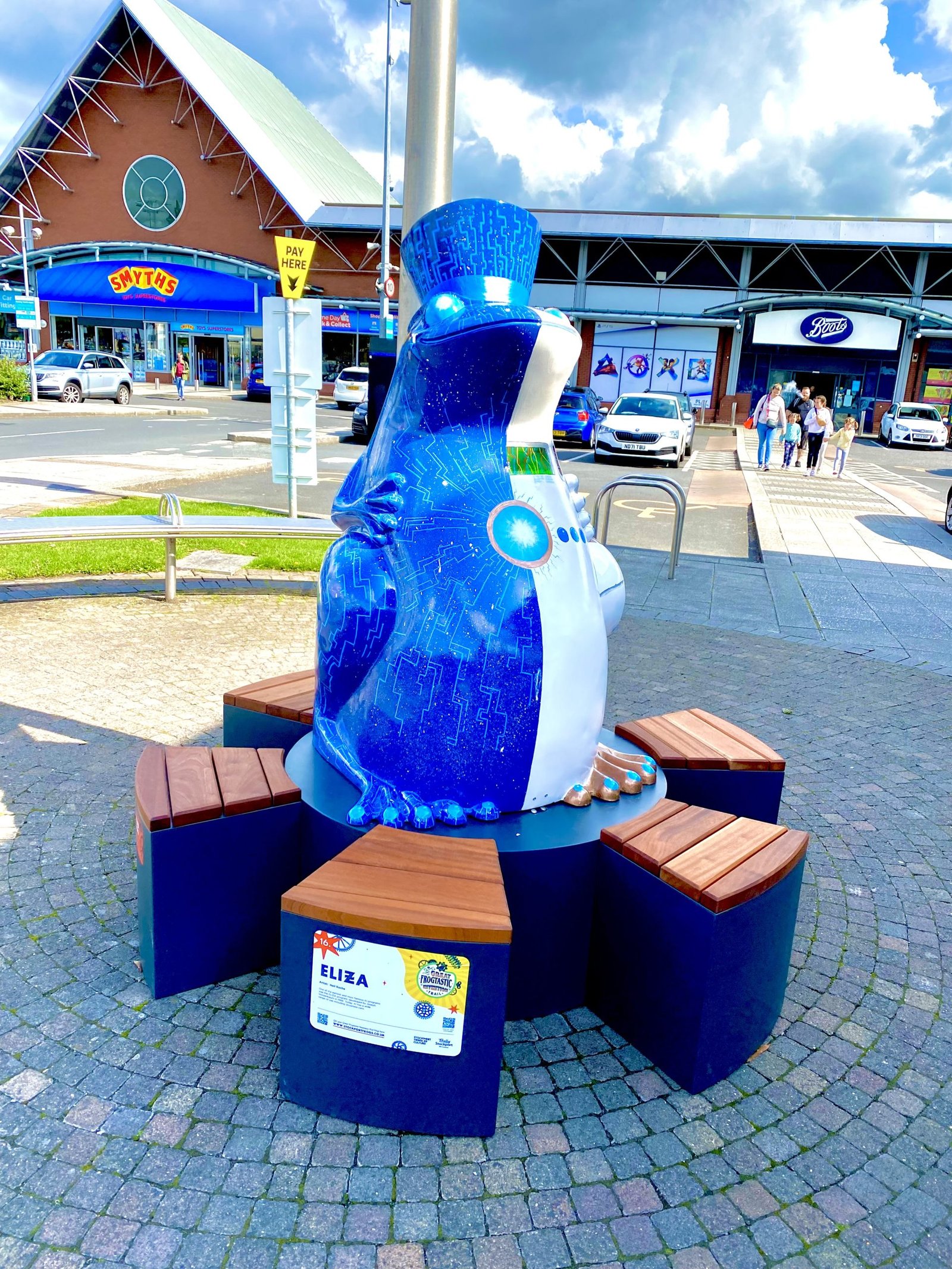
Artificial intelligence, or AI for short, is the science and engineering of making machines that can think and act like humans. Some people say it was invented by Alan Turing, who came up with the famous Turing test to see if a machine can fool a human into thinking it’s another human. Other people say it was invented by John McCarthy, who coined the term “artificial intelligence” and organised the first conference on the topic in 1956. But whoever invented it, AI has come a long way since then, and now we have smart assistants, self driving cars and chess champions. Isn’t that amazing? Or maybe a little scary? I guess it depends on your perspective.
Instagram : @Bhuna1967
Auction : Lot 4
Charity : Signpost for Carers
Frog 17. “Heidi” – The Printing Press – By Caroline Coates

Did you know that the printing press was invented by a guy named Johannes Gutenberg in the 15th century? He was a genius who figured out how to make movable metal type and use it to print books faster and cheaper than ever before. Thanks to him, we have access to tons of literature and knowledge that would otherwise be lost or hidden. He also made a lot of enemies who didn’t like his revolutionary ideas. Poor Johannes had to deal with lawsuits, debts, and even a plague. But he never gave up on his dream of spreading the word…literally! He printed the first mass produced book, the Gutenberg Bible, which is considered one of the most valuable and influential books in history. He also printed pamphlets, calendars, and other documents that helped shape the culture and politics of his time. He was a pioneer of mass communication and a hero of the Renaissance.
Instagram : @CarolineCoatesArt
Website : https://www.creativecoati.co.uk/
Auction : Lot 14
Charity : Smart Works
Frog 18. “Fredison” – The Lightbulb – By Toubie Scott

Did you know that the lightbulb was not invented by a single person, but by quite a few people who kept improving on each other’s ideas? The first electric light was made by Humphry Davy in 1802, but it was too bright and too hot to use. Then, over the years, different inventors tried different materials for the filament, the part that glows inside the bulb. Some used platinum, some used carbon, some used bamboo. Finally, in 1879, Thomas Edison found a way to make a long lasting bulb with a carbonised cotton thread. He patented his invention and became famous. But he wasn’t the only one who contributed to the history of the lightbulb, he was just the most successful at marketing it.
Instagram : @ToubieJack
Website : https://www.toubiejack.com/
Auction : Lot 11
Charity : Stockport NHS Charity
Frog 19. “PC” -The Computer- By Karis Lambert

We all know that computers are amazing, so amazing that we all walk around with one in our pockets! But who made them? Well, it’s complicated. Some say it was the abacus, a toy with beads for counting. Some say it was Charles Babbage, a British man who dreamed of a metal machine that could crunch numbers. But the first electric computer was by John Atanasoff and Clifford Berry in the 1930s. They used tubes and caps to make a thing that could solve equations. Too bad nobody knew about it as they didn’t patent it. So the glory for the first electric computer goes to John Mauchly and J. Presper Eckert, who made the ENIAC in 1946. The ENIAC was massive and weighed 30 tons, it was so big that it filled an entire room. It could do 5,000 math problems per second, which was amazing, but it was also lvery oud and buggy. The ENIAC was used for war and science calculations, like shooting guns and blowing up atoms. It was not until the 1950s that computers got smaller, faster, and better, thanks to transistors and circuits. These things led to personal computers, laptops, phones, and the web. Now, computers are everywhere and we use them for everything.
Sponsored by : Nexperia
Instagram : @KarisViola
Website : https://www.etsy.com/uk/shop/KarisViolaLambert
Auction : Lot 5
Charity : Stockport Without Abuse
Now that you’ve learned a little more about the inventions and the artists behind each sculpture…what are you waiting for, get bidding!

